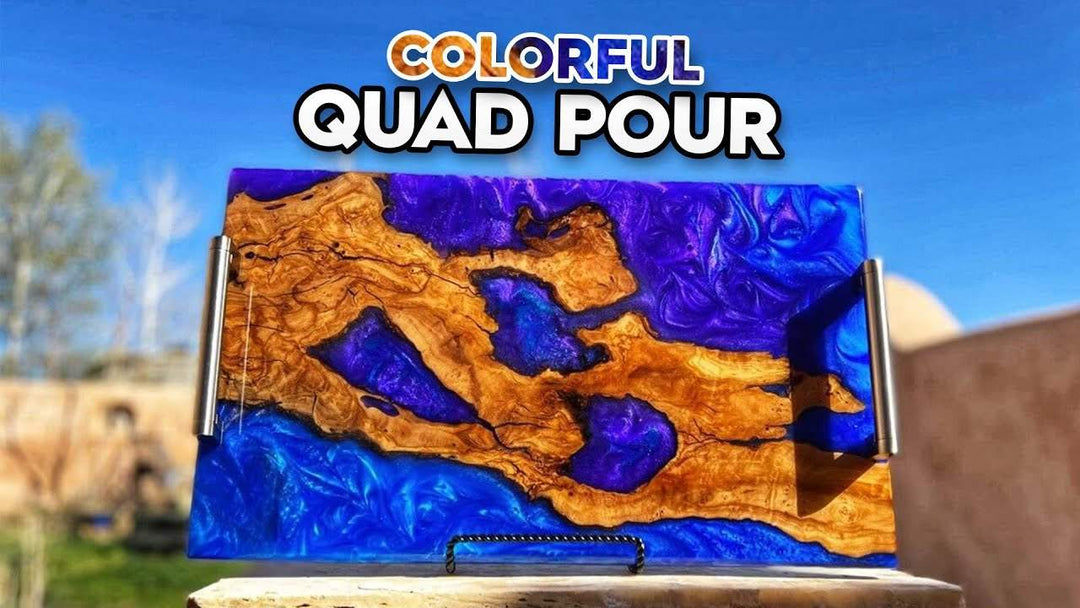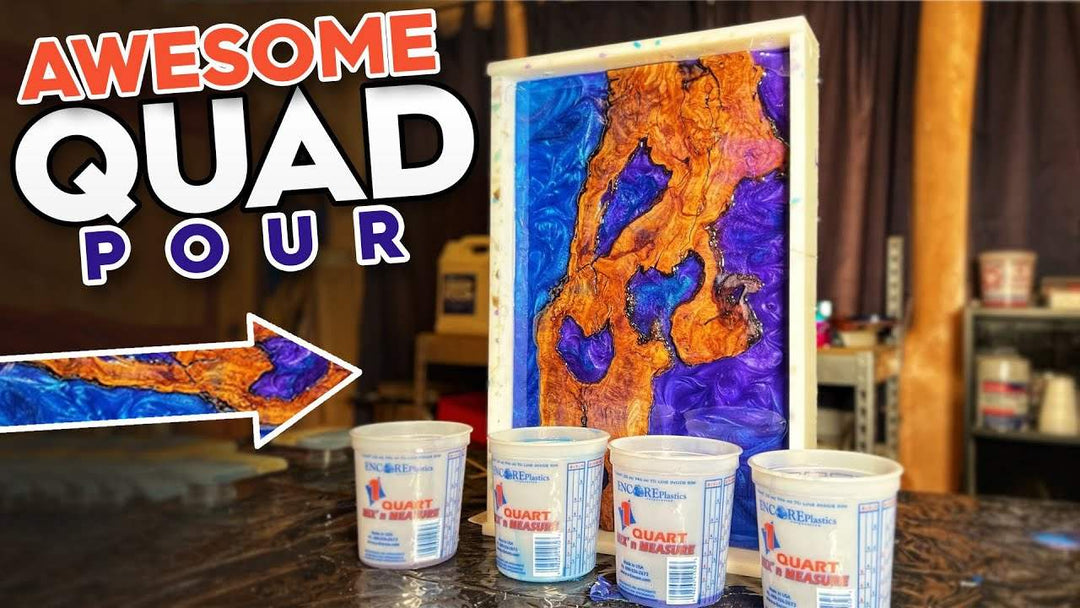
How To Get The Perfect Pour With Deep Pour Epoxy Resin!
Our deep pour epoxy formula is perfect for river tables, ocean tables, wall art, and so much more! Want to try it, but not sure where to start? Jason with Upstart Epoxy walks you through the entire resin pouring process, from mixing all the way to the deep pour itself. This is a perfect tutorial for those who want to make epoxy wood art.
Skill Level: Beginner/Intermediate/Expert
Estimated Working Time: N/A
What You’ll Need:
Upstart Epoxy Deep Pour Resin
Upstart Epoxy Table Top Resin
Upstart Epoxy Powdered Pigments Set
Wood Slab
Blocks
Tyvek Tape
Acrylic Mold
Blow Torch
Denatured Alcohol
Planer
Preparing for Resin Pouring
Let’s do a little prep work before getting started pouring resin!
First, we took an acrylic mold that we made ourselves and lined it with Tyvek tape. Next, we dropped a walnut wood slab inside of it. Laying around, we've also got a few cleanup supplies, a blow torch, and denatured alcohol.
Don’t forget to have a few blocks lying around too! These are for holding down the wood slab, so that it doesn't float away in the resin. We're looking for a pearlescent cinnamon color to compliment the walnut wood, so we went with Gold Red (OR2) from the powdered pigment set. Now, let’s start to work with the deep pour!

How Much Resin Should You Be Pouring?
Now, let’s talk about calculating resin amounts. For projects like this, we like to use the coverage calculator on our website. To get the most accurate results, we take 12 points equal distance along the length, and then measure the empty volume at those points, for both length and depth. Plug these numbers in and it will generate your estimated epoxy usage, which is very helpful for beginners! We placed our blocks down on the wood in preparation for the pour.
Our calculations for this project was 4.5 liters of deep pour epoxy, or 1.2 gallons. The deep pour epoxy resin is a two to one ratio formula by volume, which means you would pour two liters of Part A and one liter of Part B. We’ll get to the remaining 1.5 liter later.
If you’ve worked with table top epoxy, you'll notice that deep pour is a lot thinner, which is great because it’s easier for air bubbles to escape. The thinner mixture is designed to release as much oxygen as possible from the mixture. That way, there's no bubbles in your final product!

Creating Your Resin
The next part of the resin pouring process involves mixing the two parts — the resin and the hardener — together. Do this carefully. The mixture will start off clear, and become cloudy as you mix, eventually becoming clear again.
When the mixture is clear, that is your indicator to add your powdered pigment to the batch. We're going for a really really deep vibrant pour with no translucency, so we added a pretty hefty amount of pigment. We’re looking for nice swirls and amazing color payoff! Go ahead and pour the mixture into the mold.
Another thing to note about the deep pour resin is its long working time! You’ll be able to work with this resin for up to 35 minutes after pouring!

Adding Layers
For this project, we’re using walnut, a very ‘greedy’ wood, meaning it's going to suck up all of the epoxy into its fibers and pores. The epoxy level is actually going to drop over time, so you can come back in a few hours, see how far your levels drop, and take the extra 1.5 liter that you have to fill it back up. Let it sit overnight, and come back in the morning to see how much epoxy needs to be added back to the mold.
When we came back the next day, we noticed that the epoxy levels had indeed dropped, so we mixed up that final 1.5 liter and poured that in, which leveled it out. For the next couple of days, we're going to allow the project to cure, watching it carefully to make sure that it cures properly. Don’t add any additional resin after the 24-36 hour mark!
After Pouring the Resin: Polishing and Finishing
It’s been a few days, and now we're ready to do a little bit more magic! We're going to demold, plane it smooth, sand it, and polish it off. These are steps that you CANNOT skip when working with deep pour- this formula is designed to be finished off, you can’t pop it out the mold and leave it at that.
Now that it’s cured and solid, we’ve popped it out of the acrylic mold. As this mold has been cut to size, pre-drilled, and countersunk, we don’t have to drill straight through it to get our mold out, which will make the entire thing crack. All you have to do is take out the already added drills and break it out by the sides.
The piece ended up being two and a quarter inches thick. We planed it down to the lowest possible point, that way we have a nice flat surface on both sides to work with! We used our CNC planer to slab flatten it, even it out on both ends, flip it over, and repeat. When we're done, we’ll have a completely parallel surface on both sides to work with.
Now, we're taking out our sander to clean up the edges and sanded it down to 320-grit. We used a mesh sanding system for this project, as mesh sanding systems are superior for epoxy applications because they don't bind up or generate too much heat. Excessive heat can be bad for epoxy, as it can soften the epoxy and ruin its curing.

Pouring a Glossy Resin Finish
We want to add a gloss coating to this piece, so we mixed up 200 grams of Upstart’s table top epoxy. Don’t forget to mix carefully! If you see any air bubbles start to come in, use a blow torch or alcohol mist to get rid of them. While mixing, make sure to scrape the edges and bottom of your mixing vessel.
Pour this clear mixture at a height of about 10-12 inches above your project. Gravity will start to do its job, naturally spreading the table top epoxy around the surface and evening itself out. Use the spreader that comes with your epoxy to bring the mixture to the edge, letting it run over on the sides.
It’s normal for a few bubbles to appear at this point, so go ahead and use your alcohol mist to give the piece a spritz and break them up. The alcohol spray works as a solvent to break the bubbles and surface tension, giving you a good, clean spillover. We’re going to leave this project to cure overnight again.
The next day, we returned and this project has turned out phenomenally! In just a few days, it went from just a walnut wood slab to an amazing high quality board that could be used as a table top or wall art piece. Deep pour is extremely resilient, cures hard, and results in great outcomes. See, resin pouring isn’t all that bad! We can't wait to see what you create!!





